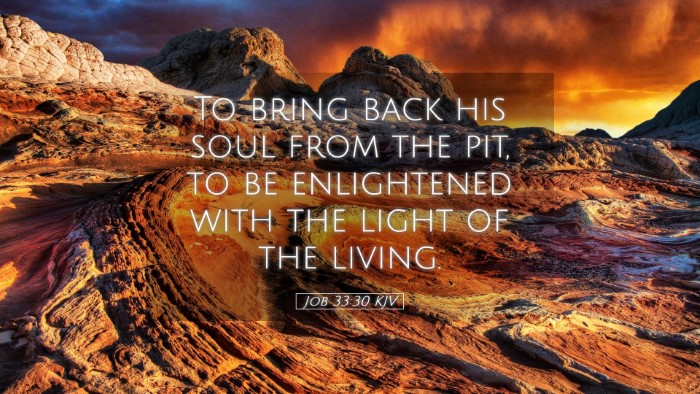Commentary on Job 33:30
Verse Context: Job 33:30 states: "To bring back his soul from the pit, to be enlightened with the light of the living." This verse is part of a discourse by Elihu, who is presenting his understanding on divine revelation and the purpose of suffering.
General Overview
This verse encapsulates a central theme in the book of Job: the restoration and redemption of the human soul. Elihu offers insight on the means by which God communicates His intentions to humanity, particularly concerning sin, repentance, and reconciliation. Scholars note that this passage illustrates God’s desire to restore and enlighten the believer.
Insights from Public Domain Commentaries
Matthew Henry
Henry emphasizes the grace and mercy of God in His dealings with humanity. He explains that the "light of the living" signifies spiritual illumination that comes through divine intervention. Henry points out that God is depicted as actively pursuing the lost, which showcases His loving nature and desire for restoration. This is in contrast to the pit, which symbolizes despair and separation from God.
Albert Barnes
Barnes highlights the nuance in Elihu’s message, noting how it reflects a broader theological understanding of suffering. He discusses how the "soul from the pit" alludes to both physical death and spiritual death. The reference to being “enlightened” suggests awakening to the truth and recognizing the need for God in our lives. Barnes articulates that this passage is an assurance that no one is beyond God’s reach, and He provides avenues for redemption.
Adam Clarke
Clarke expands on the metaphor of light, associating it with God’s truth and wisdom. He remarks that the resurrection from the pit may also imply the transformation that comes through suffering – a process through which God’s faithful can emerge renewed and enlightened. Clarke encourages readers to view suffering not merely as punitive, but as a means through which God can reveal Himself and prepare the believer for eternal life.
Theological Implications
These commentators collectively reinforce the understanding that Job 33:30 underscores the dual nature of God’s relationship with humanity – a relationship characterized by both judgment and mercy. Such duality invites readers to reflect on their personal experiences of suffering and restoration.
The Nature of Divine Communication
The verse suggests that God communicates truth through various experiences, including suffering. Elihu serves as a reminder that hardships may act as divine instruments to refine and enlighten the spirit. This reflects a supportive understanding that God desires to be intimately involved in the lives of His creation, seeking not to destroy but to redeem.
Redemption and Restoration
The mention of the "light of the living" implies that through God's intervention, there is hope of resurrection and renewal. This concept resonates deeply within Christian theology, mirroring the redemptive work of Christ, who brings light and life to those in darkness (John 1:4-5). Pastors, scholars, and students alike are invited to recognize the sacredness of God’s redemptive work as a continuous theme throughout scripture.
Application for Today’s Believers
- Understanding Suffering: Believers are encouraged to view suffering as a potential catalyst for spiritual growth and awareness of God’s presence.
- Embracing God’s Mercy: The promise of restoration reminds us that no matter how far one feels from God, His pursuit for restoration is ever-present.
- Living in the Light: The call to be “enlightened” challenges believers to continually seek God’s truth and guidance in their lives.
- Hope in Redemption: The assurance found in Job 33:30 serves as a powerful reminder of the hope of resurrection and the transformative power of God’s love.
Conclusion
Job 33:30 presents a profound understanding of God’s interactions with humanity. Through the lenses of these esteemed commentators, readers can appreciate the layers of meaning within this verse. It is a call to acknowledge the divine light that emerges amidst the darkness of despair – an invitation to restoration, enlightenment, and hope. As such, this passage serves not only as a theological reflection but also as a practical guide for believers navigating their journey with God.


